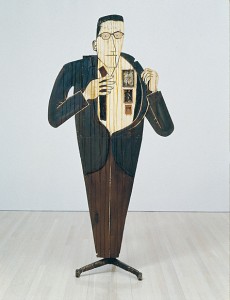Coronet Louvre Theater
During the 1950s, the Coronet Louvre gained a reputation as Los Angeles’s best venue for art cinema. The Coronet combined art house, international, and avant-garde cinema. The theater was run by the infamous Raymond Rohauer, who gained equal attention for his cutting-edge programming and allegedly unseemly business practices. In the mid-1950s, Edward Kienholz organized exhibitions of other artists’ work in the foyer of the Coronet Louvre Theatre, negotiating with Rohauer to use the space free of charge in exchange for remodeling work.
Works of Art
-

Walter Hopps Hopps Hopps, 1959, Edward Kienholz. Paint and resin on wood, printed color reproductions, ink on paper, vertebrae, telephone parts, candy, dental molds, metal, pencil, and leather. 87 x 42 x 21 in. The Menil Collection, Houston, Gift of Lannan Foundation. © Nancy Reddin Kienholz. Photo: Susan Einstein



